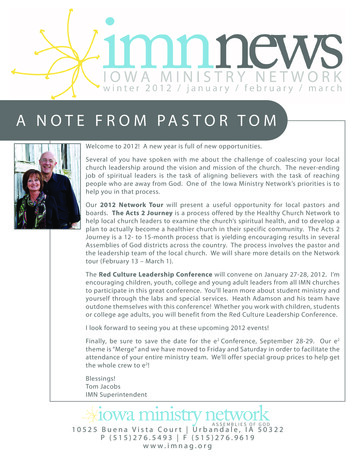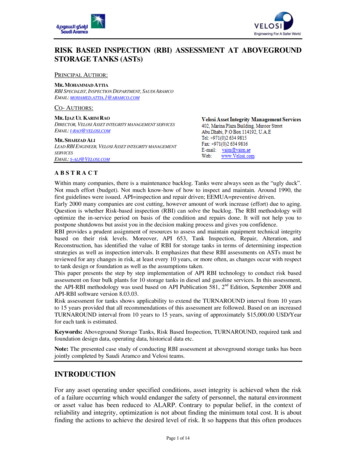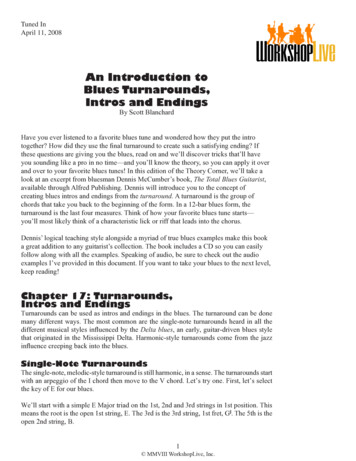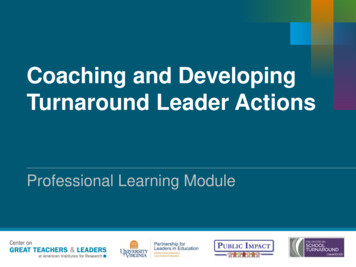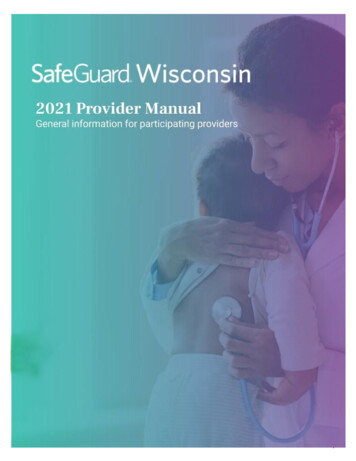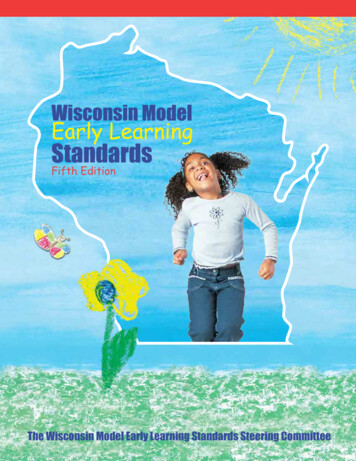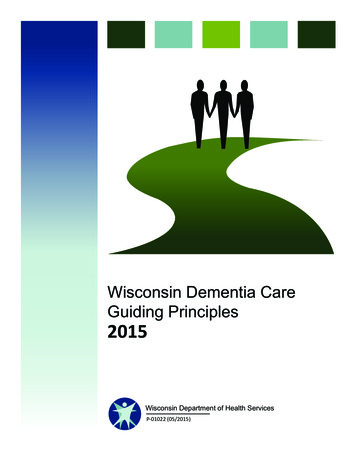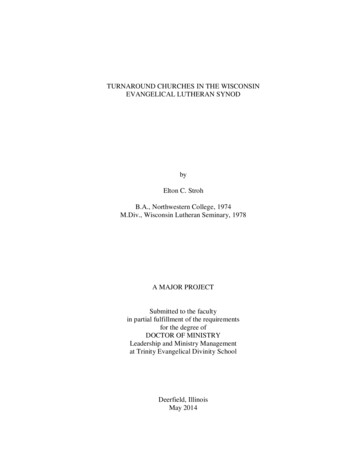
Transcription
TURNAROUND CHURCHES IN THE WISCONSINEVANGELICAL LUTHERAN SYNODbyElton C. StrohB.A., Northwestern College, 1974M.Div., Wisconsin Lutheran Seminary, 1978A MAJOR PROJECTSubmitted to the facultyin partial fulfillment of the requirementsfor the degree ofDOCTOR OF MINISTRYLeadership and Ministry Managementat Trinity Evangelical Divinity SchoolDeerfield, IllinoisMay 2014
Accepted:Project MentorSecond ReaderProgram Directoriii
ABSTRACTThere is crisis in the traditional American church. A multitude of churchesthat were once stable or thriving are now struggling and hoping to survive. Local ministryand denominational leaders, as well as church consultants, wrestle with how best to helpthese plateaued and declining congregations.This project focused on turnaround churches in the Wisconsin EvangelicalLutheran Synod (WELS) and attempted to discover the primary factors that appeared to beassociated with their turnaround. Turnaround churches were defined as congregations thatdeclined at least 20 percent in worship attendance after which, by God's grace and blessing,they rebounded and rose above their original status (before their decline started) by at least20 percent and then sustained or increased their new worship average.The findings were intended to help inform and better enable WELS churchconsultants to assist congregations with pursuing turnaround and be more helpful to stablecongregations that yearned to have improved health.Four foundational doctrinal issues were highlighted in this project primarilybecause they particularly lay a solid scriptural foundation for desiring and pursuingturnaround. It was the hope and prayer of the writer that considering these four issues wouldhelp to minimize the tensions that could easily exist in a congregation or denomination wherethere is both a high priority on remaining faithful to God's Word and conducting aggressiveoutreach, especially through innovative methodology. Other issues and perspectives wereiv
explored from related contemporary literature, predominantly in reference to cultural shiftsand changing demographics, striving for church health, and enabling needed change. Thecounsels in these resources underscored the complexities related to assisting churches withturnaround.As intended, key factors were identified that appeared to be associated withworship decline, turnaround, and sustaining or increasing positive gains. One findingpointed to the significance of the pastors' influence, which was primarily negative duringdecline and constructive during turnaround. As worship attendance increased or gains weresustained, other positive factors associated with pastoral leadership became more influential.Also, both during turnaround and sustaining worship attendance, a persistent focus onserving and reaching others appeared to be a prominent factor.v
To those who encouraged, instructed, mentored, supported,and prayed for me as I served my Savior
CONTENTSLIST OF ILLUSTRATIONS .xACKNOWLEDGMENTS .xiLIST OF ABBREVIATIONS . xiiCHAPTER1. INTRODUCTION .1Statement of NeedTopic Relationship to the Ministry of the WriterScope and Limitations to the ProjectGoals and Objectives2. THEOLOGICAL AND BIBLICAL ISSUES . 18Knowing God's Gracious HeartOwning Christ's Make-Disciples MissionDepending on God's Powerful Means of GraceGathering an Audience through AppropriateMethods3. ISSUES FROM RELATED CONTEMPORARY LITERATURE. . 90Cultural Shifts and Changing DemographicsStriving for Church HealthEnabling Needed Change4. PROJECT METHODOLOGY . 160Methodology Used to Achieve Goals and ObjectivesNarrative Description of Project Executionvii
Project ResultsReview of Research Process5. PROJECT CONCLUSIONS. . 181Analysis of Gathered DataAdditional Team AnalysisResults AchievedSynthesis within Ministry Context6. PROJECT REFLECTIONS. . 205Lessons LearnedConsiderations for the FutureAPPENDIX1. STATEMENT OF BELIEF--THE MEANS OF GRACE . 2182. THE ABSOLUTE EFFICACY OF THE MEANS OF GRACE ANDTHE RELATIVE EFFECTIVENESS OF METHODS OFCOMMUNICATING GRACE . 2193. LIFE CYCLE AND STAGES OF CONGREGATIONALDEVELOPMENT . 2234. INITIAL INVITATION EMAILED TO PASTORS . 2245. INVITATION TO CONGREGATION TO PARTICIPATE IN THETURNAROUND CHURCHES STUDY . 2266. INFORMED CONSENT ACKNOWLEDGMENT--PASTORS . 2287. PASTOR INPUT QUESTIONNAIRE . 2298. PASTOR INTERVIEW OUTLINE . 2329. INITIAL INFORMED CONSENT ACKNOWLEDGMENT--LEADERS . 23310. LEADER INPUT QUESTIONNAIRE . 234viii
11. GROUP INFORMED CONSENT ACKNOWLEDGMENT--LEADERS . 23612. LEADER CONSULTATION OUTLINE--GROUP SESSION. 23713. INFORMED CONSENT ACKNOWLEDGMENT FOR MEMBERSURVEY . 23814. MEMBER SURVEY . 23915. INFORMED CONSENT ACKNOWLEDGMENT GROUPSESSION--MEMBERS . 24116. GROUP SESSION OUTLINE--MEMBERS . 24217. INFORMED CONSENT ACKNOWLEDGMENT FOR ASSOCIATESASSISTING WITH THE RESEARCH . 24318. ORIENTATION FOR ASSOCIATES ASSISTING WITH THERESEARCH . 24419. REPORT FINDINGS--ASSOCIATE RESEARCHERS . 24520. INFORMED CONSENT ACKNOWLEDGMENT ASSESSMENT TEAM . 24921. ASSESSMENT TEAM AGENDA . 25022. CATEGORIES--STUDIED CONGREGATIONS . 25223. SUMMARIES OF THE RESEARCH FINDINGS . 25324. PRIMARY COMMON FACTORS . 290REFERENCE LIST. 292ix
ILLUSTRATIONSFigurePage1. WELS total souls by year .42. Example of a defined turnaround congregation . 153. Causes of salvation . 644. The four dimensions of planning . 1445. Strategic thinking and acting model . 1466. Life cycle of a congregation . 1547. Life cycle revisioning . 1568. Life cycle restructuring . 1579. Life cycle and stages of congregationaldevelopment . 223x
ACKNOWLEDGMENTS"To him who sits on the throne and to the Lamb be praise and honor and gloryand power, for ever and ever!" (Rev 5:13, unless otherwise noted, all Scripture references areto the NIV). Dear Lord, "Your kingdom come, your will be done on earth as it is in heaven"(Matt 6:10).I am grateful to my associate researchers who ably assisted me with thisturnaround churches project. What an honor it has been to serve with these kingdom-mindedmen on our cohesive consultant team assisting God's people with pursuing his mission!Thanks to the pastors, elected leaders, and other informed members of theturnaround congregations for their willing participation in the research. The insights gainedwill, prayerfully, be a blessing to many.Thanks to all the congregations and other ministries that invited me to becometheir ministry planning partner while I served as a consultant with and directed WELS ParishAssistance and, now, Crossroads Consulting Ministry. Praise God for all his blessings!Thanks to Trinity Evangelical Divinity School for providing an enlighteningand beneficial educational experience, especially to those who taught quality courses andguided me in shaping and writing this major project.Thanks to my family for continually encouraging and holding me accountablefor completing this major project, especially while I was experiencing some setbacks.xi
ABBREVIATIONSACAugsburg ConfessionApolApology of the Augsburg ConfessionFC SDFormula of Concord, Solid (Thorough) DeclarationFWLSForward with Lutheran SchoolsNIVNew International VersionPAParish AssistanceRHMRedemptive-Historical MethodSASmalcald ArticlesSCSmall CatechismSTMSystematic-Theological MethodWELSWisconsin Evangelical Lutheran SynodWLQWisconsin Lutheran Quarterlyxii
CHAPTER 1INTRODUCTIONIncreasingly, comments made by Wisconsin Evangelical Lutheran Synod(WELS) clergy, elected leaders, and other church members--often spoken with angst--aretelling. To paraphrase: Our congregation is dying, and we don't know what to do to save it.We used to have two hundred kids in Sunday school. Today it is about sixty. I think we haveto merge with our sister congregation about five miles to the east. They're declining too.Our church has no clue how to connect with people moving into our community. We don'tknow them, and they don't know us. We don't have many younger families. To make mattersworse, lots of us are growing older and are dying off. If we don't figure out how to doministry in this new world of ours, it is just a matter of time before we close our doors.Statement of NeedFrom California to Connecticut, Canada to Alabama, and especially in theMidwest where WELS congregations are concentrated, such concerns are commonplace.And I know the WELS is not alone. Many other church bodies are experiencing similaranxieties. There is crisis in the traditional church. But why? A short answer here, in a singleword, is change--both within congregations and their communities. A longer answer willfollow in this project when considering Issues from Related Contemporary Literature andcovering Cultural Shifts and Changing Demographics.1
2One visible sign of crisis in the traditional church is the number of books andother resources that are being written to help congregations that are struggling. Some ofthese include the word turnaround in their titles. Examples are Turn-around Churches(George Barna), The Turnaround Church (Mary Gifford), and Leading TurnaroundChurches (Gene Wood). One Doctor of Ministry project is entitled Turnaround ChurchMinistry: Causes of Decline and Changes Needed for Turnaround (Daniel Eymann).There are scores of other books that identify challenges and offer solutions tocongregations under titles that include phrases like comeback churches, breakout churches,church revitalization, congregations in transition, renew your congregation, leadingcongregational change, leading a dying church, and death of the church. At least two bookshave crisis in their titles: The Church in an Age of Crisis (James White) and The AmericanChurch in Crisis (David Olson). Add to these resources the ever-growing list of printed anddigital articles that address the above subjects from various perspectives.Another visible sign of crisis in the traditional church is that primarilyplateaued and declining congregations routinely call on church consultants to help themanalyze what is happening and not happening in their parishes. Usually they want someoneto spend a few days with them, fix their problems, point them in a positive direction, andguarantee they will experience fruitful ministry in the coming years. If only assistingcongregations through consulting was that simple.This is the ministry to which the Lord has called me. In a little corner ofGod's church militant on earth, there is a confessional church body called the WisconsinEvangelical Lutheran Synod. The WELS began in 1850, through the efforts of three
3determined German pastors who met in Milwaukee, and is now the third largest Lutheranchurch body in America. The WELS has the reputation of being theologically conservativeand confessional. At the end of 2011, based on the synod's statistical report, this rather smallgathering of God's people that walks and works together was comprised of 383,506 souls in1,286 congregations--most of which are justifiably described as traditional--within twelvegeographic districts within the United States.The WELS maintains two preparatory high schools, a ministry trainingcollege, and a seminary. These synod-operated schools focus on providing pastors, teachers,and staff ministers. Synod congregations, either individually or as federations, operate thefourth largest denominationally-affiliated private school system in the country comprised of403 early childhood ministries, 324 elementary schools, and twenty-three area high schools.Over the last twenty years WELS has provided one of the largest prisonministries in the nation, distributing hundreds of thousands of Bible correspondence coursesalong with Bibles to inmates across the United States. This church body is also active intwenty-two world mission fields serving 533 congregations with 86,502 baptized members.The WELS has a blessed history--a remarkable record of God's amazinggrace--during which a sizeable number of men, women, and children have been blessedthrough confessional Lutheranism. A multitude of sin-stained souls, in and through thischurch body, has been assured that Jesus is their all-sufficient Savior. No wonder so manywithin the WELS are concerned that their treasured church body has been declining.The tipping point was in 1990. Prior to that year, the WELS had experiencedmany decades of sustained growth. Alarmingly, since 1990, soul membership (including
4both children and adults) has decreased by 37,887 or 9 percent, from an all-time high of421,396 down to 383,506. The dramatic loss of children during the span of these years, from1990 through 2011, was 23,300. This represents a 22.5 percent decrease in the number ofWELS children (infants through eighth grade). During the same twenty-one years, thenumber of adults decreased by 14,587 or 4.6 percent. The chart below illustrates why somany who are affiliated with the WELS are so concerned.Figure 1. WELS total souls by year.This contraction within the WELS has captured the attention of manysynodical, district, and congregational leaders. Repeatedly, public and private conversationshave raised questions. Why is this decline happening? What has changed? What should wedo about it? What should we not do? WELS leadership has framed these concerns with thisquestion: "What does a congregation look like when it is putting into practice all of the good
5things that the Holy Spirit is prompting people to do when the gospel is clearly preached andthe sacraments are properly administered?" (Synodical Council Update 2012, accessed May1, 2012).There is much to be thankful for in the WELS, including a number of healthycongregations that are excitedly expanding their ministries, positively impacting theircommunities, passionately reaching the lost for Christ, and enthusiastically nurturingbelievers to know, love, and serve their Savior. Some of these same churches were not sohealthy in the past--and the symptoms of their poor health were obvious--until the Lordenabled them to experience turnaround. Spirit-given confidence demolished their despair,and by God's grace they experienced growth over time and with God's blessing.My goal in this project was to study some of these turnaround congregationsin depth and discover the primary factors that appeared to be associated with the manner inwhich the Lord had blessed them. These findings were intended to help inform and betterenable our WELS consulting ministry to assist other congregations with pursuing turnaround.I was hopeful the findings would be helpful both to congregations that needed and desiredturnaround and to more stable congregations that yearned to have improved health for thesake of having greater spiritual impact among their members and in their communities.Topic Relationship to the Ministry of the WriterI suspect the Lord began to stir in me a concern about church health and theneed for turnaround as I was growing up in a rural community in North Dakota. The churchin which my parents faithfully participated was a great blessing to me. There my faith wasstrengthened by the Holy Spirit through a methodical exposure to God's Word, first in
6Sunday school, then in catechism classes, and continuously in weekly worship. Participationin worship, however, was sometimes a struggle. To be blunt, I perceived worship to besomewhat bland, and I was sometimes bored. Yes, I know I was often the problem because Iwas too sleepy or easily distracted or didn't put adequate effort into listening, concentrating,or absorbing. But was it just me?The manner in which worship was led and the way people participatedsignaled to me that something was amiss. Most, if not all of the members, had the responsiveparts of the liturgy memorized so that The Lutheran Hymnal was seldom opened to thetraditional Order of Morning Service or Order of Holy Communion. These were the onlytwo liturgies used. If the hymnal was opened, it was probably more out of habit than need. Itdidn't help that a couple of our pastors, by the way they led worship, seemed to send thesignal that they were a bit bored themselves.It was especially during the last couple years of grade school and the firstcouple years of high school that I began to analyze my thoughts and reactions to myhometown worship experiences. There were times when I really didn't want to go to churchwith my family. But after participating in those services, I was glad I was present because Ialways benefitted from them. How could I explain these perplexing experiences, not wantingto participate in worship but, afterwards, glad that I did?Certainly, God was at work through his powerful Word. This explains how Icould benefit even when, initially, my head and heart were not into it. However, when Ianalyzed my worship experiences, including those times when I was both engaged anddisengaged, I drew some conclusions.
7Pastors, in part, influence how people worship. Their tone of voice, gestures,and facial expressions may or may not engage the worshippers. One pastor in particularreally made it easy for me to listen to God's Word, and I believe the Lord used him to moveme in the direction of serving in the public ministry.I also concluded that I was most attentive to those parts of the liturgy thatchanged weekly (e.g., the hymns, Scripture lessons, sermons, and prayers). I would oftenreturn home humming the melody of a hymn and pondering its meaning or rememberingsome portion of the spoken Word. The responsive parts that were the same every week didn'tseem to capture my attention or stick with me. Those I often mumbled mindlessly frommemory, as it seemed others were also doing.I know my conclusions could be challenged, again pointing the finger ofblame at me. Yes, but these were real experiences for this farm kid who was, at the time,trying to make sense out of my on-and-off reluctance to participating in worship.These early impressions so stuck with me that, when I entered the publicministry, I talked with my church leaders about offering worship that included more variety.Because I highly valued our liturgical heritage and ancient worship forms but was alsoconcerned about meaningfully engaging easily-distracted attenders, we worshipped straightfrom the hymnal half of the time and used alternative paths of worship the other half. Thealternative worship was still liturgical in form (including an invocation, confession,absolution, Scripture lessons, sermon, hymns, creed, communion, prayers, and benediction),but especially the repetitive responsive components were modified primarily by includingadditional Bible passages.
8I made sure that proclaiming law and gospel and focusing on the means ofgrace were central to every worship experience, and I checked in with my leaders every sooften to ensure that this practice was still preferred and appreciated. The leaders alwaysresponded affirmatively, and their positive responses were validated based on many personalconversations with worship participants.It helps to step back from one's normal routines and practices occasionally toreflect on why we do what we do in the way that we do it. This brief pausing for honestanalysis often helps us to assess and confirm what is appropriate and challenge and changewhat is not consistently accomplishing its intended purpose. This is especially helpful whenministry context changes and, with the passing of time, it always does. Looking back,pausing to analyze was a worthwhile practice throughout my parish ministry years.I began to serve my Savior in the public ministry in 1978 upon graduationfrom Wisconsin Lutheran Seminary, Mequon, Wisconsin. I was privileged as a parishpastor, over a period of twenty-four years, to shepherd two flocks of lambs and sheepgathered by the Lord. These congregations were quite different, each providing a valuableand instructive experience that would be of benefit to me as a church consultant.My first call to public ministry was an assignment to start a new congregationin a large, ethnically diverse metropolitan area. I was warmly welcomed both by the smallnucleus of people who were my church-launching partners and by the folks in my newneighborhood. One neighbor met me in the middle of the street just after my wife and Imoved into our rented parsonage. Upon hearing I was a Lutheran pastor called there to starta new church, he raised his hands to the heavens and yelled loudly, Praise the Lord!
9With only a few interested families assembled in this new start we prayed, setout to gather more people, and trusted the Lord to bless his gospel work. We mostly knockedon doors, asked probing questions, expressed loving concern, shared God's truth about sinand grace, and invited folks to join us for worship and Bible study in a variety of rentedfacilities. The Lord blessed these meager but consistent efforts to gather an audience for hisWord. The Spirit did his work and soon there were enough of us to secure a loan, purchaseland, and construct a multipurpose facility for worship, education, and fellowship.Both the urban setting and the ethnic diversity were eye-opening for this farmkid now turned pastor. Picturing a little red cross on the foreheads of all the people I met andserved, as encouraged by my district president, was a blessing both to them and me. Butpastoral inexperience combined with passionate enthusiasm for expanding God's kingdomand growing a church in the process left me with a few regrets.One regret was not focusing on enabling and empowering members to becomeactive in all areas of ministry. This was driven home to me when, after moving on to anothercongregation, I received a phone call from one of the leaders back at that original church.Apparently, with the approach of spring, the grass needed to be mowed on the church lot.What was the problem? I was the only one who mowed the grass, so no one knew how tostart or operate the mower-equipped farm tractor. After talking the person through thenecessary steps, I hung up the phone and said to myself, I think the Lord just sent me amessage that will change how I function as a pastor.The Lord next positioned me to serve him for the following seventeen years asa senior pastor in a long-established congregation. When I arrived in 1985, a number of
10attentive members described their congregation as lethargic. A few people privately broughtto my attention the presence of a protracted conflict that had been, among other factors,paralyzing their church for decades. Over the years, anxiety within this congregation hadincreased, especially among the leaders. Everything else had been declining.There was low member ownership of ministry, appalling worshipparticipation, only a handful who gathered to study Scripture, and negligible concern forbringing the good news of salvation in Christ to the lost. There was, however, a growingsense of restlessness among some who knew this intolerable state of affairs in theircongregation could and must change.I recall feeling as though I was standing in a deep valley looking up at aninviting mountain top beyond some hazardous cliffs. How daunting! I wondered how thisstill sizeable but waning assembly--a group of what appeared to be mostly apatheticpeople--would ever become a healthier congregation. Would we ever overcome theobstacles and ascend to such scenic heights? I prayed for wisdom, strength, and patience.It was clear to me that only the Lord could enable such a climb and, with hisblessing, effect the changes that were needed. Based on that deeply-held conviction, themost important priority was to involve as many of God's people as possible, as often aspossible, in a thorough study of his Word. We needed to know God's heart, have confidencein his promises, and pursue his purposes with passion. Only the Spirit could make thathappen through his Word, so we promoted both personal and group Bible study.Slowly but steadily attitudes and actions were amended as the Lord workedpowerfully in the hearts and minds of his people, turning many from lethargy to activity.
11Participation in worship and other existing ministries increased. New ministry programsdeveloped, engaging more. Members talked optimistically about their improving church.Outreach efforts were initiated. More were instructed in God's Word and, as the Spiritworked within them, they yearned to unite with this expanding family of faith.Excitement was in the air as the culture of the congregation gradually changedfor the better. Certainly, there were still challenges to address and disappointments toendure. Especially during the early years some people had their boat rocked and left loudlywhen their comfortable, albeit unbearable, status quo was challenged. In spite of thosepainful negatives, the Lord was undeniably doing something special at this church.After about a dozen years of experiencing progress on our way out of thevalley and up the mountainside, I sensed the congregation was losing traction. Based onworship attendance, we were no longer moving upward. It was as if we had hit an invisibleceiling, and I wanted to know why. We had heard about Parish Assistance (PA)--the churchconsulting ministry of the WELS--so we made contact and sought their assistance.After their comprehensive analysis, we better understood our predicament.Key among the impacting factors that were holding this congregation back were (1) our lackof physical space on our church campus and (2) continuing to function like a program-sizedchurch even after becoming a corporate-sized congregation. PA walked us through thesubsequent phases of the ministry planning process. This enabled the congregation to createa compelling and agreed-to vision for future ministry, which included purchasing propertyfor a second campus in the same community.
12Participating in the PA ministry planning process was enlightening andinvigorating. The Lord used our consultants to help me see more God-given potential inmyself and the people of this church. My passion for serving my Savior increased along withmy determination to position more people to serve in roles that were appropriate for them. Iwas amazed at how the Lord blessed us through this consulting ministry. Consequently,when I was asked to assist as an associate PA consultant, I enthusiastically agreed. Again, Iwas blessed immensely by those experiences.In 2002, the Board for Parish Services of the WELS called me to serve as aconsultant in this ministry on a full-time basis. A few years later, in 2006, I became thedirector of WELS Parish Assistance. As director, my main objective was to advance thepurpose of PA, which was to assist God's people with pursuing his mission. Primarily, Iprovided overall direction to this consulting ministry, set its operational policies, selected andhelped to train its full- and part-time lead and associate consultants, strived to improve itsmaterials and services, and developed new services when deemed appropriate.Since its inception in 1992, PA had the privilege of serving almost fivehundred client congregations, including those served by a school consulting ministry knownas Forward with Lutheran Schools (FWLS), a division of PA's consulting group. PA servedscores of congregations more than once, so it was obvious the services were appreciated. Infact, the Lord blessed this consulting ministry beyond expectations. A comprehensive surveydistributed among served congregations demonstrated a high degree of satisfaction. Wellover 90 percent indicated they would recommend PA's services to other congregations.
13Initially, this Turnaround Churches in the WELS project related directly to myPA administrative role, and I was hopeful that the findings of this effort would significantlyenhance my ability to function with greater proficiency as the director of this consultingministry. Clearly, the more I benefited from this project personally, the more I would be ablessing to others as I continued to serve WELS congregations.Unfortunately, as the field work for this project was underway, some leaderswithin the WELS began to talk about serious funding shortages and the probable need to cutboth ministry programs and positions. Their prognostications were both alarming andaccurate. There were many reductions in programs and personnel among all the divisions ofthe synod, including the termination (defunding) of WELS Parish Assistance. This meantthat my call as director of this consulting ministry was also terminated.I concluded (at the time this was happening) that the termination of PA andmy call was bad news both for me and for my beloved synod. I was convinced, based on myconsulting experiences, that the type of assistance PA offered was still desperately desiredand urgently needed by many WELS congregations.The good news (praise the Lord!) was the encouraging response of manycoworke
This project focused on turnaround churches in the Wisconsin Evangelical Lutheran Synod (WELS) and attempted to discover the primary factors that appeared to be associated with their turnaround. Turnaround churches were defined as congregations that declined at least 20 percent in worship


